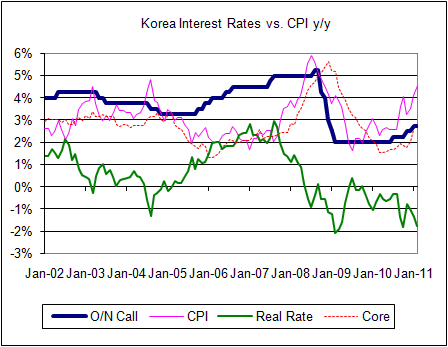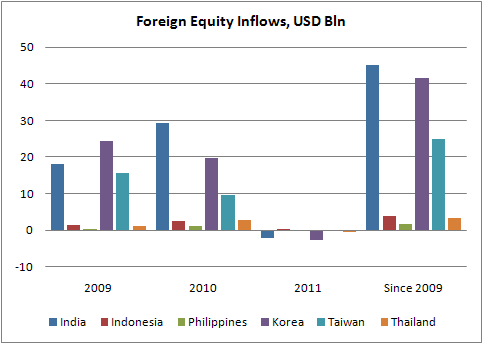Korean Rate Hike Needed As Inflation Accelerates
By Win Thin
Korea February inflation data came in much higher than expected, and supports our view that a rate hike on March 10 is a done deal. The central bank kept rates steady February 11 after a 4-2 vote in favor of a 25 bp rate hike on January 13. Inflation continues to rise above the 2-4% target range, coming in at 4.5% y/y vs. 4.1% y/y in January. Furthermore, core inflation continues to accelerate and came in at 3.1% y/y vs. 2.6% y/y in January, the highest since August 2009. As we have noted before, the pass-though from headline to core is typically very quick in EM, and Korea is no exception. We think that Korea is increasingly being viewed as being behind the curve with regards to inflation, with BOK very reluctant to hike rates. As a result, foreign investors remain very jittery. So far this week, Korea has seen about -$258 mln in foreign equity outflows, and comes after a -$3.1 bln outflow in February. In Asia, Korea has seen the biggest YTD outflow, at -$2.6 bln. While this is dwarfed by its 2010 inflow of $19.7 bln, the trend should be worrisome for policy-makers.
Real interest rates remain deeply negative and a strong case can be made for more aggressive tightening. On the other hand, we know that BOK is very reluctant to hike given concerns about a strong won. We think the near-term won outlook will hinge in large part on what the BOK says and does March 10. A rate hike then would likely see the won move back towards 1100. Since Bank Indonesia surprised with a 25 bp hike on February 4, IDR has been the top performer in Asia vs. USD (up 2.1%). Conversely, continued BOK dovishness would likely see the won suffer further losses with potential to test the November-December highs around 1172 for USD/KRW. While that would seem to play into the hands of Korean officials that want a weaker won, we note that borrowing costs for the government have risen steadily in 2011, just as they have for other countries that are seen as behind the inflation curve. By trying to target both inflation and the exchange rate, BOK (and many others in EM) risks suboptimal levels for both.


Comments are closed.